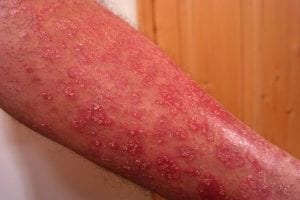Acknowledgment: This story is sponsored by Janssen Pharmaceuticals and is promoted through the Patient Worthy Collaborative Content program. We only publish content that embodies our mission of providing relevant, vetted, and valuable information to the rare disease community. If you would like to share your plaque psoriasis story, consider joining the Janssen SHARE Network to help inspire patients around the world. More details below!
Psoriasis is a skin disorder characterized by areas of itchy, scaly or flaky skin. As the National Institutes of Health explains, there are several different types of psoriasis and the most common form is called plaque psoriasis (also sometimes called psoriasis vulgaris). This type is distinguished by patches of raised, inflamed skin, typically covered with a hardened, crusty layer and most commonly appears on the scalp, back, elbows and knees.
This is the typical description of plaque psoriasis that you would find if you were searching for information online. While this information isn’t inaccurate, this description doesn’t actually give the full picture of what plaque psoriasis can look like. The standard description of plaque psoriasis is based on how the condition appears on people with white or lighter-colored skin. If you’re a person with darker skin, the typical description may not line up with what you’re seeing.
Plaque psoriasis can look different on darker skin than it does on lighter skin, as the National Psoriasis Foundation explains. Whereas redness around the affected areas is common on lighter skin, this may not be the case in people with darker skin. People of color with psoriasis are also more likely to experience skin discoloration, such as hypopigmentation (in which the skin lightens) or hyperpigmentation (in which the skin darkens). Other differences between plaque psoriasis in people with lighter skin versus people with darker skin include the following:
- The hardened plaque layer can present in shades other than white or silvery in people of color. In fact, the plaques may appear brown or purplish gray.
- While people of color are thought to be less likely to develop plaque psoriasis, they are more likely to experience more severe cases with thicker plaques and more scaling. Plaque psoriasis may also be under-diagnosed in darker-skinned people.
As a paper published in the June 2022 edition of the Journal of Rheumatology outlines, the focus on lighter-colored skin can put patients/people of color living with plaque psoriasis at increased risk of delayed diagnosis or even receiving an incorrect diagnosis. In addition, lack of awareness of these differences in clinical presentation can make it harder for doctors to accurately diagnose plaque psoriasis in people with darker skin.
How to Get Involved
It’s clear that education about the variability of plaque psoriasis between different skin colors is needed, both among the general public and in the medical field. This will help give patients the confidence to advocate for themselves and give physicians the knowledge to make more accurate diagnoses.
One solution to this problem is helping to spread awareness about plaque psoriasis and how it can present differently across different tones of skin. A critical aspect of spreading awareness is through patients sharing their own stories about living with moderate to severe PsO.
If you are living with plaque psoriasis and want to share your story, you may want to consider joining the Janssen SHARE Network, which is a volunteer program dedicated to helping people share their health journeys to inspire others. Hearing about your experiences with plaque psoriasis — especially how your diagnosis journey may have been different because of the way symptoms presented on your skin — can be just the thing someone just like you needs to hear.
Help make a difference for your patient community today!







